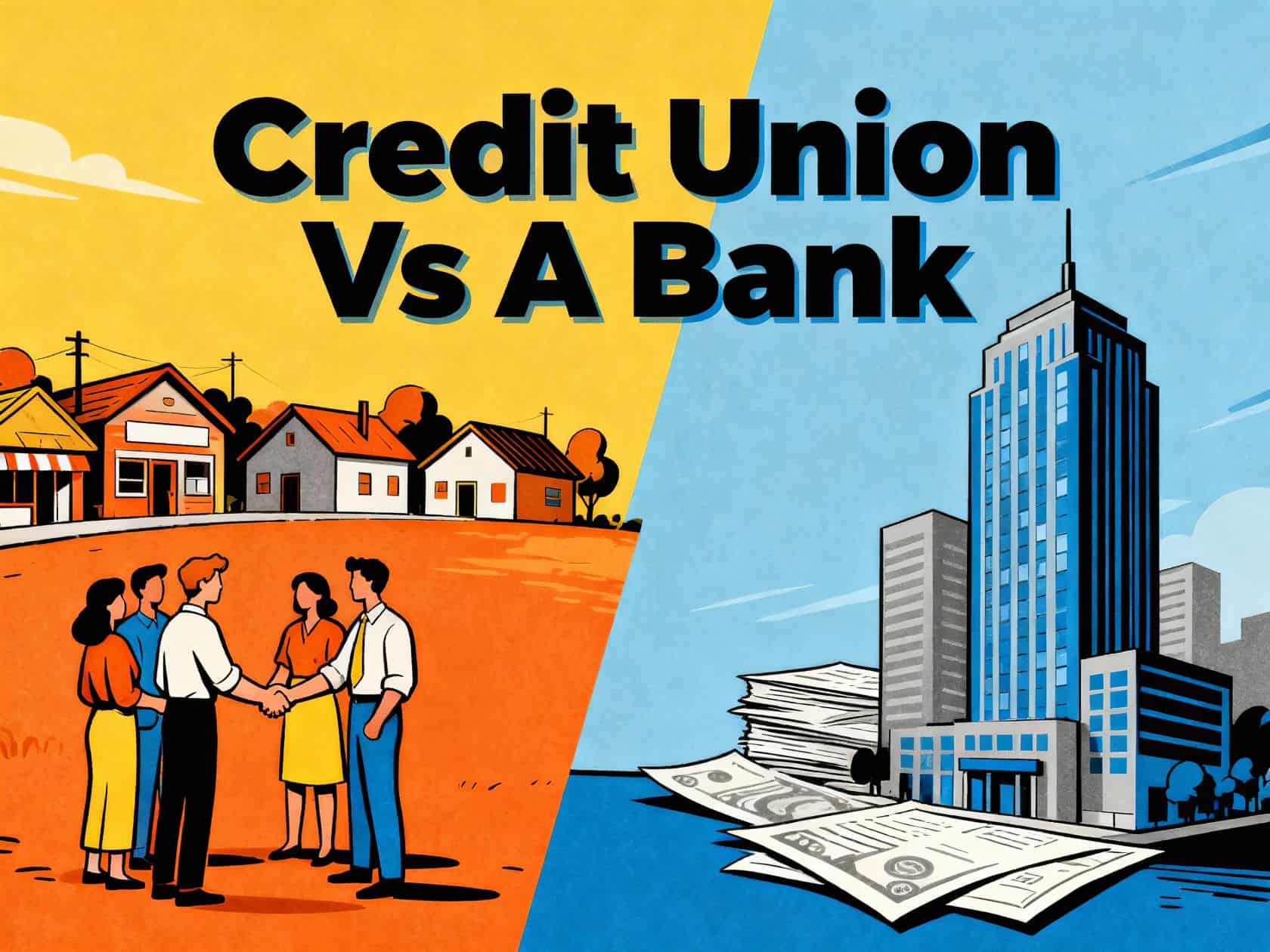Have you ever stood there wondering if you’re making the right choice between a credit union and a bank? It can feel a little overwhelming, especially when they both seem to offer the same things, like checking accounts, savings accounts, and even auto loans.
Here’s the little secret that changed everything for me: credit unions are not-for-profit groups, while banks are built to make money for their owners.
This guide on the great “Credit Union Vs A Bank” debate will break down everything from interest rates and deposit insurance (you’ll see names like FDIC and NCUA) to fees and customer service. I’m going to walk you through it in simple terms to help you decide.
Let’s figure out which one is the winner for your wallet this year.
Key Takeaways
Credit unions are not-for-profit and owned by their members, which means profits are returned to you. Banks, on the other hand, are for-profit and answer to shareholders like those at Chase or Wells Fargo.
You’ll often find higher savings rates at credit unions, with many high-yield savings accounts offering over 4.50% APY in late 2025. They also tend to have lower loan interest rates; for example, a 2024 report showed the average 60-month new car loan at credit unions was 6.78% APR, while banks were higher at 8.75% APR.
Big banks definitely have more of their own branch locations. Chase, for example, has over 4,700 branches in the U.S. But credit unions team up through networks like the CO-OP Shared Branch, giving you access to over 30,000 ATMs and more than 5,600 branches nationwide.
Your money is safe at both. The National Credit Union Administration (NCUA) insures credit union deposits, and the Federal Deposit Insurance Corporation (FDIC) insures bank deposits, both up to $250,000 per depositor.
Both offer strong digital banking, but credit unions are catching up fast. According to a 2024 survey by Cornerstone Advisors, 22% of credit unions planned to select a new digital banking provider that year, showing a major push to improve the member experience.
Table of Contents
Key Differences Between Credit Unions and Banks

The biggest difference really comes down to who they serve. Credit unions belong to their customers and have a people-first focus. Banks are businesses that aim for profit and answer to investors.
While the rules for joining a credit union used to feel a bit strict, both keep your money safe with federal insurance from either the NCUA or the FDIC.
How are credit unions owned and governed?

At a credit union, the members are in charge. When you join, you typically buy a “share,” which might only cost $5 or $10. That simple step makes you both a customer and an owner.
A friend of mine joined her local credit union through her teaching job and was so surprised when she got to vote in its annual election. She said it felt just like voting for the school board, but for her bank.
A volunteer board of directors, who are also members, runs the credit union. Everyone gets an equal vote in electing this board, no matter how much money is in your account. This structure helps prevent the kind of risk-taking that can lead to a bank failure.
Because these are not-for-profit cooperatives, any earnings are returned to members through things like lower rates on auto loans, fewer overdraft fees, or even special dividends at the end of the year.
As Carrie Hunt from America’s Credit Unions points out, this member-focused approach is all about “growing membership and welcoming newcomers.”
If you’re looking for some of the best credit union checking accounts, you might be surprised by how much say you have compared to a big bank where shareholders call the shots.
What is the difference between not-for-profit and for-profit institutions?

Credit unions operate as not-for-profit entities. They exist to serve their members, not to generate profits for outside investors. This means they put their earnings back into the credit union, which usually results in lower account maintenance fees and better interest rates on both savings and loans.
Their tax-exempt status also allows them to support local communities directly. It’s a big reason why your credit card or car loan often costs less with a credit union.
Banks are for-profit businesses owned by shareholders, with major players like Chase or Wells Fargo leading the pack. Their primary goal is to make a profit, which is why customers often see higher transaction fees and lower rates on deposits.
Unlike credit unions, banks must pay federal income taxes. As of early 2024, there were 4,568 FDIC-insured commercial banks compared to 4,686 federally insured credit unions under NCUA rules, so the numbers are pretty close.
Services and Product Offerings

You can find everyday banking options like checking, savings, or short-term loans at both places. But the details can look a little different.
With choices ranging from IRAs to credit cards, finding the right fit for your financial life might be easier than you think.
What financial products do credit unions and banks offer?

Both credit unions and banks offer a full menu of financial products. You’ll find standard options like checking accounts, savings accounts, and certificates of deposit (CDs) everywhere.
For example, in late 2025, you can find competitive CD rates from places like Discover Bank, offering around 4.05% APY for one year. At the same time, some credit unions, like Alliant, offer rates that are just as competitive, proving they can keep up with the big players.
You can also find more flexible options, like the no-penalty CD from Marcus by Goldman Sachs, which offered a 3.90% APY on a seven-month term.
Loans and credit cards are also on the menu. This includes:
- Car loans and mortgage loans
- Personal loans for things like debt consolidation or home repairs
- Short-term payday loan alternatives
- Unsecured lines of credit
Both also offer access to debit cards, money market accounts with competitive rates, and retirement savings vehicles like IRAs. Some even partner with investment platforms like Wealthfront Brokerage LLC or Betterment Cash Reserve to offer integrated cash management tools.
If you need help deciding which card to pull out of your wallet, a helpful credit vs. debit card usage guide can make the choice clearer.
How accessible are loans and credit at credit unions versus banks?

Big banks often stand out for their ability to provide large loans and high credit limits. Because they have more capital, you might find it easier to get a very large mortgage or business loan from them. Community banks, a subset of the banking world, are also powerhouses for small businesses, providing nearly 60% of all small business loans under $1 million.
Credit unions are fantastic for everyday borrowing. They often have more flexible lending criteria because they know their members personally. This can be a huge help if your credit report isn’t perfect.
Most consumer loan rates at credit unions are capped by the NCUA at 18%, which protects you from runaway interest charges. For short-term payday-style loans, that cap is 28%. Banks don’t have this federal cap, so their rates can sometimes be much higher.
While banks might deal in bigger numbers, credit unions often focus more on the people behind the application.
And don’t worry about strict membership requirements. Many credit unions have opened their doors wider than ever. You can often join by working for a certain employer, living in a specific county, or even by joining an affiliated nonprofit organization for a small donation.
Fee Structures and Costs

Hidden fees can be a real budget-killer. Banks and credit unions can surprise you with costs for accounts, ATM use, or non-sufficient funds.
Let’s take a closer look at these costs, because it could save you a lot of money in the long run.
What maintenance fees do credit unions and banks charge?

Credit unions are well-known for keeping maintenance fees low, and many even offer free checking accounts with no strings attached. Because they’re not-for-profit, they’re more focused on serving members than on generating fee income.
You can often get a monthly fee waived just by using direct deposit or maintaining a modest balance. I’ve found that my credit union also offers little perks, like free cashier’s checks, that really add up.
On the other hand, banks often have higher monthly maintenance fees unless you meet specific requirements, like keeping a large minimum balance. A 2023 study from Bankrate found that the average monthly fee for interest-bearing checking accounts was over $16.
Extra charges can also pop up for things like using a non-affiliated ATM or closing an account early. These non-sufficient funds penalties and other costs can make banking with larger firms feel more expensive over time.
How do transaction fees compare between credit unions and banks?

Every dollar really does count, especially when it comes to those surprise bank fees. Here’s a quick breakdown of how transaction fees typically stack up, so you can see the difference for yourself.
| Fee Type | Credit Union | Bank |
|---|---|---|
| Non-sufficient Funds (NSF) Fee | $28.36 (avg) | $31.24 (avg) |
| Overdraft Fee | Lower, often a single fee per day. The CFPB has noted lower rates here. | Higher, and some may charge multiple times per day. |
| ATM Fee | Often lower or waived for network use. Many refund out-of-network ATM fees. | Higher out-of-network fees are common, and fee refunds are rare. |
| Wire Transfer Fee | Usually lower, especially for domestic transfers. Some offer free incoming wires. | Higher fees for both incoming and outgoing transfers are typical. |
| Credit Card Late Fee | $24.56 (avg) | $34.18 (avg) |
| Early Account Closure Fee | Rarely charged. | More common, and can be $25 or more. |
| Foreign Transaction Fee | Lower, and some credit cards have none. | Higher, often around 3% of the transaction amount. |
From my own experience as a busy mom, the lower overdraft fees at my credit union have been a lifesaver more than once. That simple difference can save you from a moment of panic!
Interest Rates and Savings

This is where things get really exciting. The interest rates you earn on your savings can make a huge difference in reaching your financial goals.
Let’s see how your money’s earning power can change depending on where you decide to save it.
How do deposit interest rates differ between credit unions and banks?

The interest rate on your savings account can either help your money grow or let it get eaten away by inflation. Here’s a side-by-side look at what you can expect from credit unions and banks.
| Institution Type | Typical Savings APY | Minimum Deposit | Key Notes |
|---|---|---|---|
| Credit Unions | Often higher than banks (commonly 4.00%+) | Varies, often $0-$10 | Because credit unions are not-for-profit, they pass profits back to members with better rates. It’s common to find high-yield accounts over 4.00% APY. |
| Forbright Bank | 4.00% APY | $0 | Their Growth Savings account as of late 2025 shows how online banks compete fiercely. |
| Axos Bank | Up to 3.60% APY (with requirements) | $0, but requirements to earn top APY | You might need to meet direct deposit or debit card usage goals to get the best rate. |
| Varo Savings | Starts at 3.00% APY, up to 5.00% APY | $0 | You need direct deposits of $1,000+ to qualify for the max rate, which applies to balances up to $5,000. |
| Discover Bank CDs | 3.50% (6 months) 4.05% (1 year) | $2,500 minimum | Good for those who can set money aside, as longer terms usually mean higher rates. |
| Commercial Banks (Large) | Often very low (0.01%-0.50% APY) | Varies | The national average for standard savings accounts often lags far behind online banks and credit unions. |
As you can see, it pays to shop around, as online banks and credit unions are often in a heated competition to offer the best rates.
What are the differences in loan interest rates at credit unions and banks?

Just as savings rates can help you earn more, loan rates can help you pay less. This is where the not-for-profit structure of credit unions really shines.
| Aspect | Credit Unions | Banks |
|---|---|---|
| Ownership Structure | Owned by members, not-for-profit. Earnings help lower borrowing costs. | Owned by shareholders, for-profit. Profits are returned to investors. |
| Loan Rate Cap | Most consumer loans are capped at 18% APR by the NCUA. | No federal cap on rates, so they can be significantly higher. |
| Average Loan Rates (2024 data) | Lower rates are common. The average 60-month new car loan was 6.78% APR. | Higher rates are typical. The average new car loan was 8.75% APR. |
| Loan Options | Excellent for auto loans, credit cards, and personal loans. | Often stronger for jumbo mortgages and very large business loans. |
| Auto Loan Example | A $30,000 car loan over 5 years at 6.78% would have a monthly payment of about $591. Total interest paid would be $5,460. | The same loan at 8.75% would have a monthly payment of $619. Total interest paid would be $7,140. That’s a difference of $1,680! |
| Personal Experience | When I got my last car loan, I went through my credit union. The process was simple, the rate was low, and they answered all my questions without making me feel rushed. | My old bank quoted me a rate that was nearly 2% higher and wanted to add an origination fee. It was an easy decision to make the switch. |
Access and Convenience

Finding an ATM on your lunch break shouldn’t be a scavenger hunt. When you’re busy, convenience is key.
With mobile banking apps and large branch networks, some institutions make it much easier than others to manage your money on the go.
How extensive are the branch networks of credit unions and banks?

Banks definitely win when it comes to the sheer number of their own branches. A giant like Chase has over 4,700 branch locations across the United States, making them a familiar sight in most cities. This huge physical presence makes them incredibly convenient for many people.
But credit unions have a clever solution. They collaborate. Through the CO-OP Shared Branch network, members of participating credit unions can use over 5,600 shared branches and more than 30,000 ATMs nationwide, often for free.
This means even if you’re traveling or move to a new city, you can likely find a “shared branch” where you can make deposits, withdrawals, and loan payments just as if you were at your home branch.
I found this so helpful when I lived in a smaller town. My credit union’s nearest branch was a bit of a drive, but I could use a shared branch right downtown, which saved me a ton of time.
What digital banking and mobile app options do credit unions and banks provide?

These days, being able to manage your money from your phone is essential. Both credit unions and banks offer robust mobile apps that let you check balances, pay bills, and deposit checks with a quick photo.
In the past, big banks had a clear edge in technology. However, credit unions are closing that gap quickly. A 2024 survey from Cornerstone Advisors revealed that 22% of credit unions were planning to switch to a new digital banking platform that year, showing a huge investment in improving the user experience.
Security is also a top priority for both. You can expect features like multi-factor authentication to protect your accounts. The 2024 American Customer Satisfaction Index (ACSI) survey showed that while large banks slightly edged out credit unions in website satisfaction, credit unions scored higher for the courtesy and helpfulness of their staff.
So while banks might still launch new features first, credit unions are rapidly catching up and often provide a more personal touch to go with their improving tech.
How Will the Landscape of Credit Unions and Banks Shift in 2025?

Looking ahead, credit unions are making a serious push into technology. Many are increasing their tech budgets significantly in 2025 to enhance their digital banking services and attract younger members who expect a seamless mobile experience.
Big banks, while still having more branches, have been slowly reducing their physical footprint since 2010. Now, they are focusing new branch openings in major metropolitan areas.
The competition for your savings is also heating up, with many high-yield savings accounts offering rates as high as 5.00% APY in November. No matter where you put your money, you can feel secure knowing that it’s protected by federal insurance, either from the NCUA for credit unions or the FDIC for banks.
Finally, the gap in customer happiness is getting smaller. The 2024 ACSI data shows that regional and community banks are scoring very high in customer satisfaction, proving that a personal touch is still incredibly important to people. This trend is forcing everyone, including the biggest banks, to focus more on providing great service.
People Also Ask
How are my deposits protected at a credit union versus a bank?
Your money is equally safe at both, with deposits insured up to $250,000 by the federal government through the NCUA for credit unions and the FDIC for banks.
What fees should I expect from banks and credit unions?
Banks often have higher fees, and a 2025 Bankrate study found the average out-of-network ATM fee reached a record $4.86. Credit unions are known for having lower or no fees for things like monthly maintenance, and some studies show members pay less than half in annual checking fees compared to bank customers.
Can I get IRAs or payday loans at both places?
Yes, both offer IRAs, and credit unions often feature competitive rates on “share certificates,” which are similar to a bank’s CDs. For urgent cash needs, many credit unions provide a much safer option called Payday Alternative Loans (PALs). These NCUA-regulated loans have interest rates capped at 28%, which is far lower than the sky-high rates of traditional payday loans.
Who owns these institutions and does it affect me?
Credit unions are not-for-profit and owned by you, the member, so profits return to you as better rates and fewer fees. Banks are for-profit and must answer to their stockholders. It is also good to know that investment products, like stocks, are protected separately by SIPC, which insures up to $500,000 in securities if a brokerage firm fails.
References
https://www.kemba.org/resources/financial-literacy/credit-unions-vs-banks
https://www.districtcreditunion.com/blog/what-is-the-difference-cu-vs-bank/
https://www.bankrate.com/banking/banks-vs-credit-unions/ (2025-06-11)
https://www.investopedia.com/credit-unions-vs-banks-4590218
https://www.northbrookbank.com/articles/2024/12/how-is-a-bank-different-than-a-credit-union.html
https://www.argentcu.org/differences-between-credit-unions-and-banks/
https://pmc.ncbi.nlm.nih.gov/articles/PMC9607735/
https://encompasscu.org/blog/comparing-bank-and-credit-union-interest-rates (2025-01-21)
https://sfcuonline.org/2024/01/03/credit-unions-vs-banks-which-offers-better-rates/
https://www.primewayfcu.com/blog/bank-vs-credit-union
https://riverwaysfcu.org/Blog/Digital-Banking/Financial-Well-being-Digital-Banking (2023-04-12)
